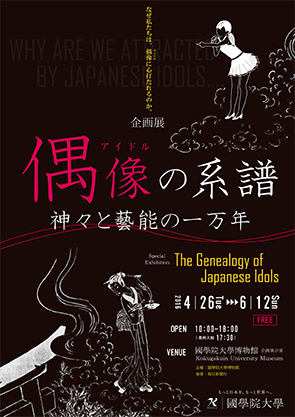April 26, 2016 (Tue) – June 12, 2016(Sun)
Why are our hearts are moved by idols?
Despite having human form, idols existence brings forth a life power that surpasses mortals. This exhibition following transitions in media produced by humans, looks at the history of Japanese performing arts, allowing us to contact things not in the here and now as well as transcendental beings such as deities (kami 神) and Buddhas. Looking back at primitive images and considering the archetypes of contemporary idols allows us to consider their origins.
* Flyer
* List of Exhibits
* Commentary
Highlights of the Exhibition
Chapter I. Archetype of Modern Idols
As for the idols we can encounter in twenty-first century Japan, they are presented as a narrow gateway to success for those who want to be professional actors, singers, and entertainers. However, this archetype can also be viewed much earlier in headlines from the eighteenth century, the middle of the Edo Period (1603-1868). The reality of these idols is introduced and reproduced in media from their eras.
Chapter II. Festival at the beginning
In the past public performing arts (geino 芸能) and festivals (matsuri マツリ) were linked. Prayers, singing, dancing, and serving the deities mixed the sacred and profane. Today, we commonly think of festivals as being for entertainment, however, originally festivals were a means of breaking down barriers to the supernatural.
Chapter III. Invisible Bodies of Deities
Originally humans could not view deities or spirits, so they are represented as sculptures shapes similar to humans. Looking at these images, we can see the ambiguous boarders between the human world and the supernatural. Where is the core of these images? Viewing Buddhist statues, images of kami, and primitive sculptures, we see the search for the roots of anima’s forms.
Outline
| Period | Tuesday, April 26 – Sunday, June 12, 2016 |
|---|---|
| Venue | Special Exhibition Gallery, Kokugakuin University Museum |
| Hours | 10:00-18:00(Last admission 17:30) |
| Closed | Friday, April 29 Saturday, April 30 Sunday, May 1 Monday, May 2 |
| Admission | Free |
| Access | 13 minutes' walk from Shibuya Station 15 minutes' walk from Ebisu Station 15 minutes' walk from Omotesando Station *Map |
| Organizer | Kokugakuin University Museum |
| Related Events | * Gallery talks * Lectures Please note that these are available only in Japanese. |










